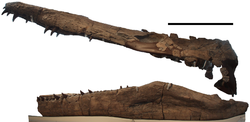Pliosaurus macromerus
|
Pliosaurus Temporal range: Late Jurassic, 155.7–147 Ma |
|
|---|---|
 |
|
| P. kevani holotype skull | |
| Scientific classification | |
| Kingdom: | Animalia |
| Phylum: | Chordata |
| Class: | Reptilia |
| Superorder: | †Sauropterygia |
| Order: | †Plesiosauria |
| Family: | †Pliosauridae |
| Clade: | †Thalassophonea |
| Genus: |
†Pliosaurus Owen, 1842 |
| Type species | |
|
†Pliosaurus brachydeirus Owen, 1842 |
|
| Species | |
|
|
| Synonyms | |
|
|
Pliosaurus (meaning 'more lizard') is an extinct genus of thalassophonean pliosaurid known from the Kimmeridgian and Tithonian stages (Late Jurassic) of Europe and South America. Their diet would have included fish, cephalopods, and marine reptiles. This genus has contained many species in the past but recent reviews found only six to be valid, while the validity of two additional species awaits a petition to the ICZN. Pliosaurus currently consists of the type species P. brachydeirus, and also P. brachyspondylus, P. carpenteri, P. funkei, P. kevani, P. macromerus, P. rossicus and P. westburyensis, as well as the invalid P. portentificus. Most species of Pliosaurus are notable for their large body size, while the others, P. brachydeirus, P. brachyspondylus and P. portentificus, are known exclusively from immature individuals. Species of this genus are differentiated from other pliosaurids based on seven autapomorphies, including teeth that are triangular in cross section.
Using Liopleurodon, another large pliosaurid, as a guide, a specimen found in the Svalbard islands of northern Europe has been estimated to have been 15 metres (49 ft) long, 45,000 kilograms (99,000 lb) in weight and had teeth 30 centimetres (12 in) long. It is estimated to have lived approximately 147 million years ago. Analysis of bones from the four flippers suggest that the animal cruised using just two fore-flippers, using the back pair for extra speed when pursuing and capturing prey. P. funkei's brain was of a similar type and size, proportionally, to that of today's great white shark, the team says. Later on, thorough scrutiny of this Svalbard specimen revealed that it was not as massive as originally claimed; total length estimates have been revised to 10–13 metres (33–43 ft).
...
Wikipedia
